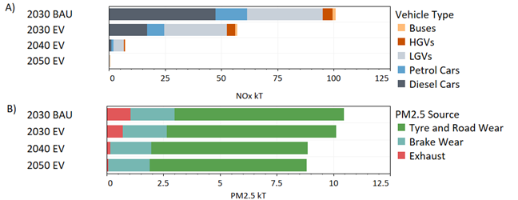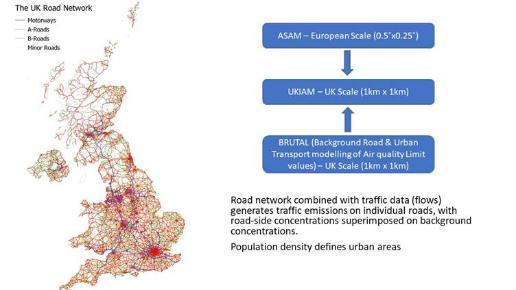Modelling of the transport sector
Road transport
The road transport sector is an important source of oxides of nitrogen (NO and NO2) and fine particulate matter, PM2.5, concentrated in urban areas and affecting air quality and human health; and also of greenhouse gases - and N2O so that synergies between measures to control air pollutants and greenhouse gases can be assessed. In addition to exposure to NO2, NOx chemistry also leads to ozone formation and nitrate aerosol, and enables deposition of nitrogen compounds contributing to acidification and eutrophication of natural ecosystems.
The BRUTAL transport sub-model (Background, Roads and Urban Transport modelling of Air quality and Limit values) estimates emissions and road-side concentrations for the whole UK road network, using data assembled on traffic flows and speeds and vehicle mixes combined with emission factors from the EMEP/EEA guidebook that are used in the National Atmospheric Emissions Inventory, NAEI. Separate calculations are undertaken of the background concentrations, with the road-side enhancements superimposed for comparison with air quality limit values.
The BRUTAL model is being applied to future scenarios, and simulation of the effectiveness of both international and national measures and technological improvements to reduce vehicle emissions; and of local and non-technical measures (behavioural change and low emission/congestion zones) affecting traffic volumes through reductions of km driven by different vehicle types, technologies and Euro standards.
The big reduction in NOx emissions expected from electrification of road transport gives substantial improvements in air quality, reducing both NO2 and secondary PM2.5. This is driven initially by improved emission control in new diesel vehicles post RDE testing, and is reinforced in the longer term by electrification of the fleet. With respect to primary PM2.5 emissions, electrification has been shown to have a small effect because of the dominance of non-exhaust emissions. However, it is likely the amount and composition of non-exhaust emissions will change due to factors such as regenerative braking reducing brake wear, heavier vehicles increasing tyre wear, or future regulation in the upcoming Euro 7 standard. Overall, electrification of road transport, even when considering the emissions produced in power plants supplying electricity for the vehicles, has been shown to have a positive impact on NO2 and PM2.5 concentrations, with a greater impact on the former.

With some technological measures to reduce non-exhaust emissions still in development, further reductions of PM2.5 ultimately depend on reducing kilometres driven, especially in London and densely populated areas. This is dependent on behavioural change rather than technological change, as well as local action in urban conurbations and by local authorities.
Modelling emissions from road transport is currently based on COPERT emission factors which have been developed to address average speeds on different types of road. Models have tended to under-estimate emissions since average speeds cannot resolve localised hotspots caused by stop-start conditions and traffic congestion. Use of alternative representations of emission factors, such as HBEFA, are therefore being investigated, together with remote sensing measurements of tailpipe emissions in real traffic situations.
Relevant Publications
-
Mehlig, D., Staffel, I., Stettler, M., & ApSimon, H., 2023, Accelerating electric vehicle uptake favours greenhouse gas over air pollutant emissions, Transportation Research Part D, 124, 103954, https://doi.org/10.1016/j.trd.2023.103954
- Mehlig, D., ApSimon, H., & Staffell, I., 2022, Emissions from charging electric vehicles in the UK, Transportation Research Part D, 110, 103430. https://doi.org/10.1016/j.trd.2022.103430
- Mehlig, D., Woodward, H., Oxley, T., Holland, M., ApSimon, H., 2021, Electrification of Road Transport and the Impacts on Air Quality and Health in the UK, Atmosphere, 12, 1491. https://doi.org/10.3390/atmos12111491
- O'Driscoll, R., Stettler, M., Molden, N., Oxley, T., & ApSimon, H., 2018, Real world and NOx emissions from 149 Euro 5 and 6 diesel, gasoline and hybrid passenger cars, Science of the Total Environment, 621, pp 282-290, https://doi.org/10.1016/j.scitotenv.2017.11.271
- O'Driscoll, R., ApSimon, H., Oxley, T., Molden, N., Stettler, M. & Thiyagarajah, A., 2016, A portable emissions measurement system (PEMS) study of NOx and primary NO2 emissions from Euro 6 diesel passenger cars and comparison with COPERT emission factors, Atmospheric Environment, 145, pp 81-91, https://doi.org/10.1016/j.atmosenv.2016.09.021
- Oxley T, Elshkaki A, Kwiatkowski L, Castillo A, Scarbrough T, ApSimon H, 2012, Pollution abatement from road transport: cross-sectoral implications, climate co-benefits and behavioural change, Environmental Science & Policy, 19-20, pp16-32, https://doi.org/10.1016/j.envsci.2012.01.004
- Oxley T, Valiantis M, Elshkaki A, et al, 2009, Background, Road and Urban Transport modelling of Air quality Limit values (The BRUTAL model), Environmental Modelling & Software, 2009, Vol:24, Pages:1036-1050, ISSN:1364-8152, http://dx.doi.org/10.1016/j.envsoft.2009.02.011.
Shipping
The rapid growth of shipping and associated emissions of atmospheric pollutants raises questions about the effect on air pollution in the UK. European countries are committed to reducing their emissions of NOx, SO2, PM2.5 and other pollutants to comply with strict emission ceilings by 2030 in a major effort to reduce transboundary air pollution. However, control of maritime emissions in Europe has been much more limited, and restricted to specific areas of the North Sea and the Baltic. Revised estimates of pollutant emissions from shipping have been undertaken by Ricardo Energy & Environment using Automatic Identification System (AIS) data from shipping as received at coastguard stations. These are more comprehensive than previous estimates and indicate substantially higher emissions from UK domestic shipping than earlier data reported in the UK National Atmospheric Emissions Inventory, NAEI. The new AIS data also indicate emissions in 2016 of 665kt of NOx from UK international shipping and in-transit shipping in sea areas surrounding the UK. This compared with 2016 NOx emissions from the whole of the UK of 927kt, with a commitment for future reduction to 477kt by 2030 (a 73% reduction relative to emissions of 1768kt in 2005 for compliance with the National Emission Ceiling Directive, NECD).
The current data provided by Ricardo Energy and Environment is based on AIS data supplied by the Maritime and Coastguard Agency for the year 2014, with future plans to update to more recent data as these become available. These 1x1 km gridded data span the important sea areas surrounding the UK that are modelled in UKIAM, which include the Channel and North Sea, and the Irish Sea, and distinguish the Emission Control Areas (ECA) for International Maritime Organization (IMO) regulations on SO2 and NOx emissions. The emission data provided from Ricardo had been adjusted to emissions in 2016 as the base year reflecting changes due to the control of SO2 within the ECA, and fleet projections.
The data covers emissions of the pollutants covered under the NECD (NOx, SO2, PM10 and VOCs, with current and historic emissions of NH3 from shipping negligible) and also CH4, CO, and N2O, with estimated consumption of fuel oil and gas oil determining emissions. Emissions are broken down to distinguish UK domestic shipping emissions, UK international shipping emissions for trips either starting or ending at UK ports, and in-transit emissions from vessels passing the UK at sea but which do not call at a UK port. Because of the importance of emissions in ports, emissions at berth have also been separated out.
Relevant Publications
- ApSimon, H., Oxley, T. & Woodward, H., 2019, The contribution of shipping emissions to pollutant concentrations and nitrogen deposition across the UK, Centre for Environmental Policy, Imperial College London, Report to Defra, SNAPCS Contract ECM-53210, December 2019, https://uk-air.defra.gov.uk/library/reports?report_id=1028
- Dore, A. J., Vieno, M., Tang, Y. S., Dragosits, U., Dosio, A., Weston, K. J. & Sutton, M. A., 2007, Modelling the atmospheric transport and deposition of sulphur and nitrogen over the United Kingdom and assessment of the influence of SO2 emissions from international shipping. Atmospheric Environment, 41 (11), 2355-2367, https://doi.org/10.1016/j.atmosenv.2006.11.013
Airports
Studies have also been undertaken of air quality in areas surrounding airports, emphasizing the role of emissions from associated road transport superimposed on other activities and infrastructure in the surrounding area.
PhD thesis: Fernando Farias (2005) Air pollution exposure and integrated assessment modelling round London's Heathrow airport.
PhD thesis: Sukaina Al Wasity (2012) Air Quality Studies at Abu Dhabi International Airport.
For staff
If you are a new CEP staff member and would like to be included on the research webpages, or would like to amend your existing details, please submit this form (login required- only works for members of CEP).
